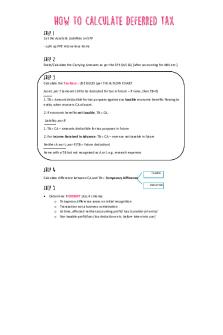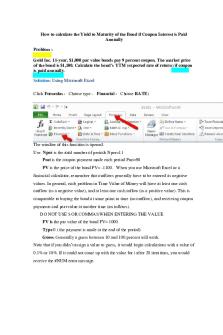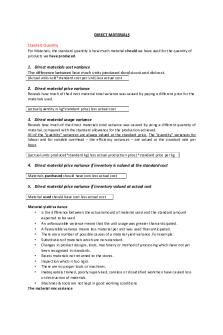How to Calculate Beta PDF

| Title | How to Calculate Beta |
|---|---|
| Author | Precious Kays |
| Course | Financial Accounting |
| Institution | Namibia University of Science and Technology |
| Pages | 2 |
| File Size | 94.8 KB |
| File Type | |
| Total Downloads | 107 |
| Total Views | 155 |
Summary
Short summary on how to calculate Beta in Cost of capital...
Description
How to Calculate Beta The formula for calculating beta is the covariance of the return of an asset and the return of the benchmark divided by the variance of the return of the benchmark over a certain period. Beta: Covariance (ri,rm )/Variance of Market Similarly, beta could be calculated by first dividing the security's standard deviation of returns by the benchmark's standard deviation of returns. The resulting value is multiplied by the correlation of the security's returns and the benchmark's returns. Beta: Correlation (ri,rm)* S.D(i)/ S.D(m) For example, an investor wants to calculate the beta of Apple Incorporated when compared to the SPDR S&P 500 ETF Trust. Based on hypothetical data over the past five years, assume the correlation between Apple Incorporated and the SPDR S&P 500 ETF Trust is 0.85, Apple Incorporated has a standard deviation of returns of 28% and the SPDR S&P 500 ETF Trust has a standard deviation of returns of 12%. The beta of Apple Incorporated is 1.98, or 0.85 multiplied by 0.28 divided by 0.12. In this hypothetical case, Apple Incorporated is considered more volatile than the market exchange-traded fund (ETF). Apple Incorporated theoretically experiences 98% more volatility than the SPDR S&P 500 Exchange Traded Fund Trust. For another example, assume the investor also wants to calculate the beta of Tesla Motors Incorporated in comparison to the SPDR S&P 500 ETF Trust. In this hypothetical case, based on data over the past five years, assume Tesla Motors Incorporated and the S&P 500 ETF have a covariance of 0.032 and the variance of the S&P 500 ETF is 0.015. Tesla Motors Incorporated has a beta of 2.13, or 0.032 divided by 0.015. Therefore, Tesla Motors Incorporated is theoretically 113% more volatile than the SPDR S&P 500 ETF Trust.
Exercise a) A share has a beta of 0.4 and an expected return of 9%. Expected return on the market is 11%. What is the risk free rate?
b) You have found that the share of Nictus Holdings pays a return of 8%. The return of an average asset at the NSX is 13%. The covariance of Nictus Holdings’ share with that of the market is 18.6 while the variance of the market returns is 9.3. Required: 1) If the three month Namibian Government Treasury Bill pays 6% currently, is the return on the share of Nictus Holdings correct or fair? 2) Explain the justification for using the beta value when calculating returns using the
CAPM....
Similar Free PDFs

How to Calculate Beta
- 2 Pages

How to Calculate Deferred Tax
- 3 Pages

How to Calculate your GPA
- 1 Pages

How to Calculate GST in a Flash
- 2 Pages

Alpha Beta and Beta Structures
- 7 Pages
Popular Institutions
- Tinajero National High School - Annex
- Politeknik Caltex Riau
- Yokohama City University
- SGT University
- University of Al-Qadisiyah
- Divine Word College of Vigan
- Techniek College Rotterdam
- Universidade de Santiago
- Universiti Teknologi MARA Cawangan Johor Kampus Pasir Gudang
- Poltekkes Kemenkes Yogyakarta
- Baguio City National High School
- Colegio san marcos
- preparatoria uno
- Centro de Bachillerato Tecnológico Industrial y de Servicios No. 107
- Dalian Maritime University
- Quang Trung Secondary School
- Colegio Tecnológico en Informática
- Corporación Regional de Educación Superior
- Grupo CEDVA
- Dar Al Uloom University
- Centro de Estudios Preuniversitarios de la Universidad Nacional de Ingeniería
- 上智大学
- Aakash International School, Nuna Majara
- San Felipe Neri Catholic School
- Kang Chiao International School - New Taipei City
- Misamis Occidental National High School
- Institución Educativa Escuela Normal Juan Ladrilleros
- Kolehiyo ng Pantukan
- Batanes State College
- Instituto Continental
- Sekolah Menengah Kejuruan Kesehatan Kaltara (Tarakan)
- Colegio de La Inmaculada Concepcion - Cebu










